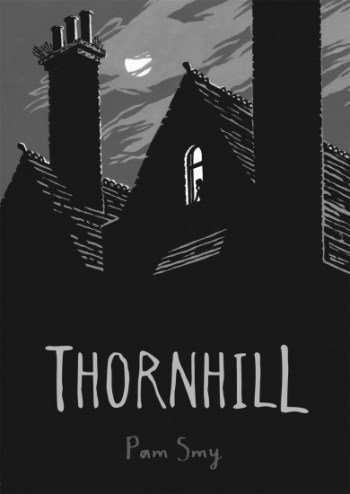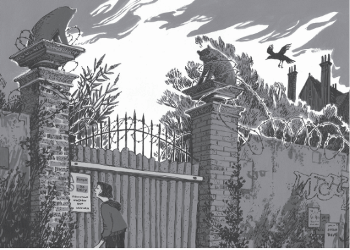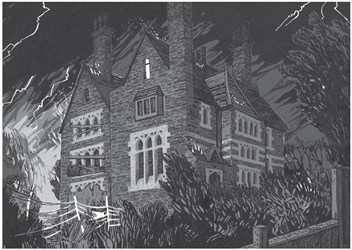
Thornhill
by Pam Smy
Roaring Brook Press, 2017
544 Pages
Middle Grade (8-12 and up)


This is both a graphic novel and a book, weaving one story in graphic format and another in prose. The story unfolds through the diary of a girl named Mary Baines, written in 1982. She lives in a home for girls, having lost her family, and is tormented around the clock by a bully with gorgeous locks of blonde curls who keeps getting sent back to the orphanage when families do not choose to adopt her. The girl who torments Mary is never named, only referred to as her in the diary.
Mary has been affected by whatever is in her past. The psychiatrists call it selective mutism. She just doesn’t talk. She can’t; It’s a painful vulnerability to speak, especially when she is surrounded by such hostile cruelty.
The second story, told in pictures (like Hugo Cabret,) is told from the viewpoint of a girl in the summer of 2017 who sees a mysterious figure in the overgrown, weed-infested grounds of Thornhill. Ella Clarke has just moved into a flat that backs up to the abandoned estate, lonely and disheartened from the loss of her mother, with her dad always working late. Ella learns more and more about Mary and her hobby of making dolls out of clay and designing clothes for them. She also learns how the girls of Thornhill make Mary’s life a living hell.
The illustrations are black and white, and capture a gothic sense of loneliness that underpins the narrative.They draw upon the romanticism of The Secret Garden while also evoking the crumbling ruins of the past.

Ella reads Mary’s life as if it were a novel, feeling a sense of familiarity, empathy, and compatriotism that grows while the reader gradually begins to sense that there is something darker behind the narrative, creeping up from behind, about to grab our insides like Old Yeller and squeeze because life isn’t always like the movie where the wronged get revenge and walk into the sunset. The ghosts of painful memories linger, and can influence the living to do things they might not otherwise do in order to find a friend.
She waits until the quiet hours then creeps up here. While the rest of the house sleeps she stands and scratches and scrapes and bangs at my door.
Thump.
Thump.
Thump.
The noise is terrifyingly loud to me in the darkness… I barely sleep at night, and during the day I sit here shaking, quaking, the sound of those thumps echoing in my head.
Though it’s a short read, it’s a pretty heavy book. It deals with mental health issues and abandonment, and it doesn’t really have a happy ending like we’ve all come to expect from a middle grade novel. It’s fun to learn about how artistically gifted the afflicted girl is with her doll-making, which makes the ending so much more emotionally intense when it comes down to just the two girls, Mary and her tormentor, locked in a mortal embrace, alone against each other and their own futures. Kerosene drips down a stairwell. Who will survive? Who is responsible? What is the figure hanging from the pantry ceiling, turning slow circles?
This is horror of the most visceral kind. It evokes the same feeling as Stephen King’s Carrie, and it will clench your gut for nights to come. At first you aren’t sure, but then it becomes clearer that Ella is, in fact, interacting with a ghostly apparition from the past. As Ella reads Mary’s diary, you also feel what it is to be in despair, in physical danger, to then come face to face with someone who can help you, and yet not be able to form the words, not be able to ask, to save yourself, trapped helplessly watching as the train slowly bears down closer and closer.
I think the most terrifying angle of all is how the adults know this torture is going on, but don’t want to get involved. Or they blame Mary for not simply deciding to overcome her challenges. It makes one want to run out and remind people that there is help out there if they are struggling with any flavor of mental illness, social phobia, bullying, or depression. Perhaps this book will motivate its readers to action.
”Just because she is a bit different doesn’t mean they should pick on her.”
“A bit different! Come on, Kathleen, she’s weird. You say they are picking on her, but we don’t have any proof… How can we help her if she doesn’t help herself? …She never smiles. No wonder no family wants her… If her speech thing isn’t problem enough, she’s also the least likeable girl we have ever had here…”
In the end, the diary does bring two friends together, despite being separated by time. Best Friends Forever. Some might call it a happy ending.

